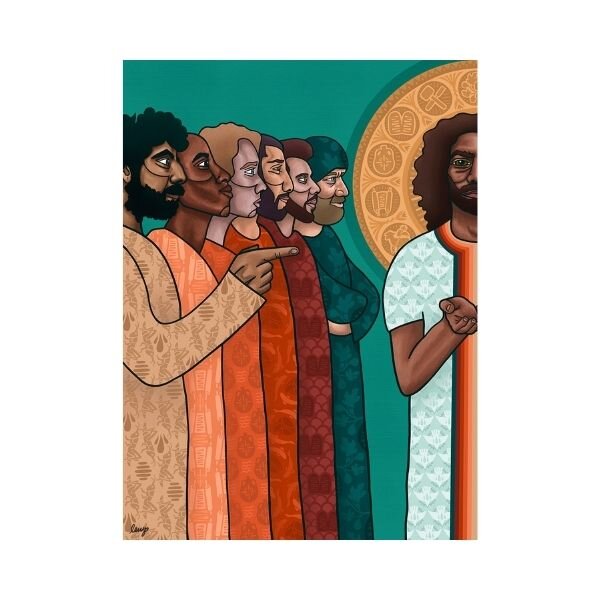Come and See Image License (John 1:35-51)
Come and See Image License (John 1:35-51)
DIGITAL DOWNLOAD FOR ONE-TIME LICENSE
Interested in licensing a single image for worship or ministry use? This one-time license grants you permission to use this image for ministry purposes. Print the image as bulletin cover art or project the art and engage with it during worship, Sunday School, or Youth Group. We hope you might use our images as tools for spiritual formation.
If you are interested in an art print of this piece, please visit our print shop.
Come and See
Digital painting
By Lauren Wright Pittman
Inspired by John 1:35-51
From our “I’ve been meaning to ask…” collection.
Order includes:
high-res image file formatted for print
high-res image file formatted for web/projection
A PDF of the Artist's statements & scripture reference for the visual
A visio divina Bible Study Guide for you to use this image in a group study session that incorporates the ancient Benedictine spiritual practice of "divine seeing."
Credit Info:
When printing and sharing online, please always include the following credits:
Artist's name | A Sanctified Art LLC | sanctifiedart.org
From the artist:
“This text paints a parade of shifting identities and assumptions, starting off with John the Baptist doing what he does best: pointing people to Jesus. One after the other, these men follow Jesus, despite the fact that not one of them has a full picture of who he is: Lamb of God, Rabbi (teacher), Messiah (anointed), the one Moses and the prophets wrote about, son of Joseph, a Nazarene, etc. Amidst these various attributes, Simon’s name even changes after meeting this mysterious man. There is something compelling about Jesus which brings all of these different people together on a common path.
Nathanael acts as many of us do. He makes assumptions and builds his own image of Jesus before even meeting him: ‘Can anything good come from Nazareth?’ (John 1:46) Nathanael’s assumptions evaporate when Jesus says he saw him under the fig tree. The text does not reveal why this convinces Nathanael, but we do know that he finds clarity and more ways of describing who Jesus is. In being seen, Nathanael is better able to fully see.
The refrain of this narrative is piercing and simple: ‘Come and See.’ Come—Jesus calls us to move, to change our position and see things from a new perspective. See—Jesus invites us into a spirit of curiosity, to open our eyes and to strive to take in the vastness of whoever is before us. As the disciples come together, each with their own experiences and particularities, a patchwork understanding of Jesus is pieced together. Like a relay, they pass to one another a glimpse of who Jesus is, and the picture gains more detail, complexity, and texture. The beauty of this text is that we need one another—from our particular, unique points of view—to be able to find understanding and to begin to take in the full picture of ourselves and the world around us. We need one another to discover the fullness of who Jesus is.
In this image, I drew Jesus’ followers each wearing a pattern that references their identity and their understanding of who Jesus is. John the Baptist’s clothes contain patterns of his unusual diet—locusts and honey—as well as three droplets of water, representing his baptism of Jesus. The unnamed disciple identifies Jesus as Rabbi and his clothes are patterned with scrolls from which Rabbis would teach. Andrew identifies Jesus as “Messiah” or anointed, and his clothes are patterned with jars of oil decorated with salvific imagery of light and the cross. Andrew, Simon, and Phillip are all from a fishing town called Bethsaida. Each of their clothes contains a reference to their hometown: Andrew with waves of water, Simon Peter with swirling fish, and Phillip with fish scales. The fish on Simon’s clothes swim around rocks which reference the meaning of his new name, Peter. Philip refers to Jesus as the one “about whom Moses in the law and also the prophets wrote.” (John 1:45) His clothes are patterned with the stone tablets etched with the Ten Commandments. Nathanael’s clothes are patterned with the very fig branches Jesus saw him under. Jesus’ clothes include the colors of all the followers’ clothes, as well as imagery symbolizing the persons of the Trinity. Jesus’ halo contains imagery referencing the many attributes the disciples use to describe who Jesus is. Do these symbols bring to mind any other names you might have for Jesus? Jesus, half in the frame, cannot be fully known or contained by our patchwork understandings.”
—Lauren Wright Pittman






